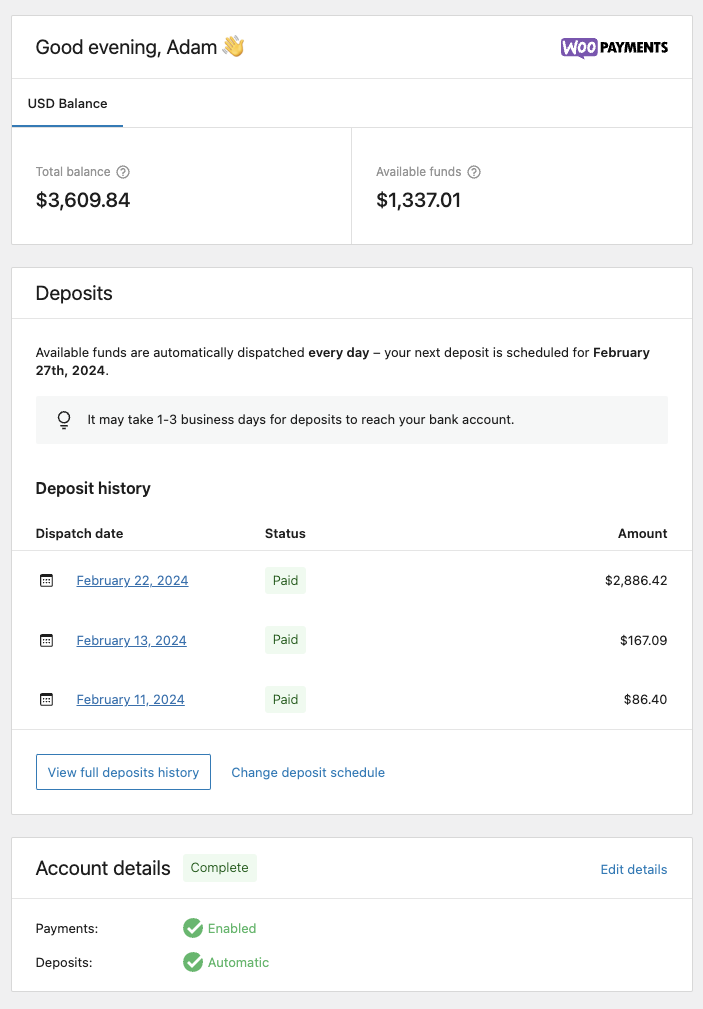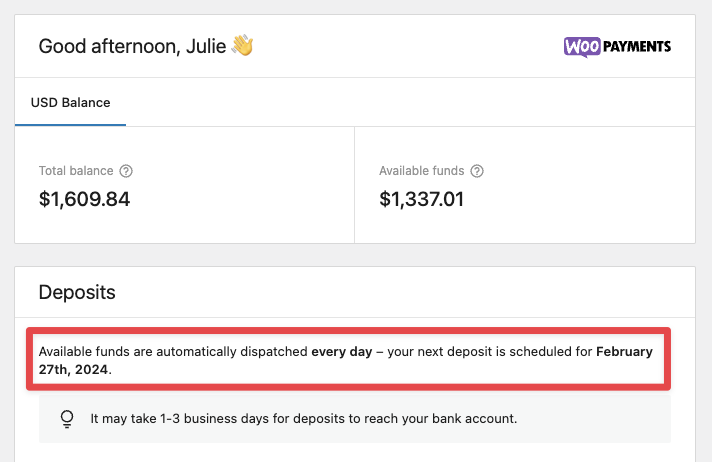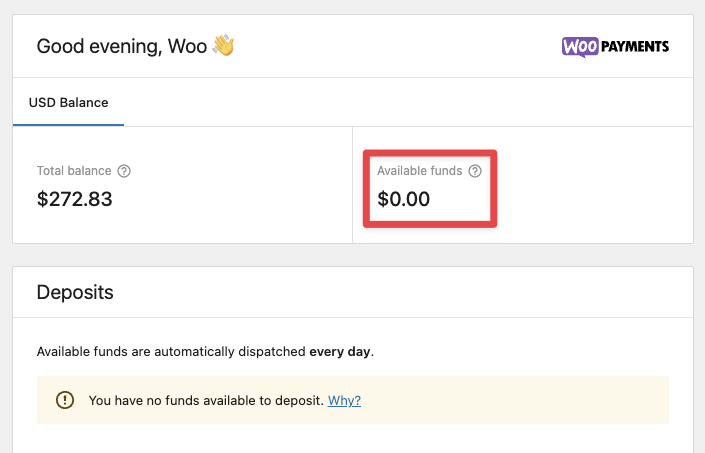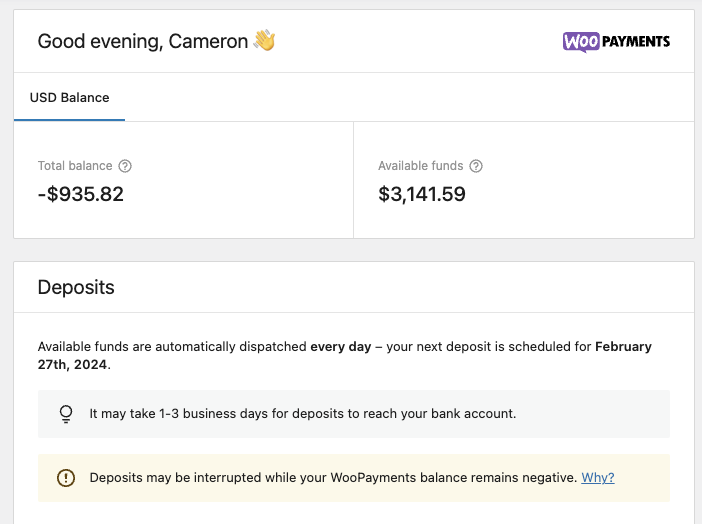Money you’ve made with WooPayments flows through a couple of states before being deposited into your bank account.
This document will provide details about when deposits occur, how frequently they can be processed, and how factors — like the amount of the deposit — can impact when a deposit is processed
Balance information
↑ Back to topThere are two balances available on your Payments > Overview page:
- Available funds
- Total balance
- This is a combination of Available funds and Pending funds

Understanding these balances is important to determine when your next deposit will arrive and how much it will be.
Pending funds
↑ Back to topWhen a transaction first takes place on your site via WooPayments, the funds take some time to process before they are available to be deposited. During this time, they are considered Pending funds, and they will not be available to be deposited until they move to your account’s Available funds balance, which is covered here.
The time those funds take to flow through your account balance is called the pending period. The length of the pending period depends on your account country. This chart shows our standard pending periods, which cannot be changed.
| Country | Pending Period |
|---|---|
| Australia, United States | 2 business days |
| Japan, New Zealand | 4 business days |
| United Arab Emirates | 5 business days |
| All other countries | 7 calendar days |
To help illustrate how this works, consider the following examples:
- A U.S. merchant makes a sale on a Friday. Their pending period is 2 business days, so the merchant can expect the funds to hit their bank account on the following Tuesday.
- A German merchant makes a sale on a Thursday. Their pending period is 7 calendar days, so they can expect the funds in their bank account a week later (e.g., the following Thursday).
NOTE: Most banks apply deposits to your account when they receive a transfer from us. However, some banks may take extra time. So, while the chart above shows the usual rolling delays, we cannot guarantee those timelines in every case.
Available funds
↑ Back to topOnce the pending period described here has elapsed, funds processed via WooPayments will move from the Pending funds balance to the Available funds balance. If funds are a part of the Available funds balance, that means that:
- Sufficient time has elapsed for the funds to no longer fall under the pending period.
- These funds are available to be deposited into your bank account.
When your account’s Available funds are positive, there will be an indication of when your next deposit is expected to arrive on the Payments > Overview page beneath the balance:

If the account’s Available funds are not positive, then there is no expected deposit. As a result, no estimated deposit date will be displayed:

If there are is a balance in the account’s Pending funds, then an estimated deposit date will appear once:
- The pending period for your account elapses.
- The Pending funds balance moves to the Available funds balance.
NOTE: Prior to December 2023, Estimated deposit details were available. Estimated deposits included information about future deposit amounts. To provide more accurate deposit information and support the expansion of instant deposits, Estimated deposit details are no longer available.
Total balance
↑ Back to topThe Total balance will provide you with a clear picture of the payments on your site. It includes the sum total of your Available funds plus your Pending funds — which means you can expect the Total balance and Available funds values to differ if you’ve had recent payments activity.
Sometimes, your Total balance value may be less than the Available funds balance.

This is usually temporary and is indicative of payments activity that can reduce your account’s Pending balance, such as when you:
- Issue a refund.
- Receive a dispute.
- Process an instant deposit.
Daily cutoff time
↑ Back to topFor deposit timing purposes, new days start at 00:00 UTC regardless of your location. As such, any payments taken after that time will face an additional delay before they’re deposited.
As an example, consider a store owner in Los Angeles who makes sales throughout the day on Tuesday. Any orders placed before 00:00 UTC (5:00pm their time) will be deposited 2 business days later (i.e., on Thursday). However, a sale made at 5:19pm will have missed the end-of-day cutoff time. The funds from that sale will arrive on Friday.
Non-business day payments
↑ Back to topPayments processed on a non-business day (i.e., a weekend day or a holiday in your country) will have their pending period start on the next business day afterward.
For example, if a U.S. store makes a sale on Saturday, the customer is charged immediately, but the pending period doesn’t start until Monday. Since the U.S. pending period is 2 business days, the merchant will get those funds the following Wednesday.
Deposit schedules
↑ Back to topThe chart and examples given above assume that your site is on a daily deposit schedule, which is the default for almost all accounts. However, it is possible to change your deposit schedule to weekly or monthly, if you wish. This will of course affect the timing of your deposits.
For example, consider a merchant in New Zealand with their deposit schedule set to weekly on Fridays. If a customer orders from their store on Thursday, 4 business days after that would be the following Wednesday. However, due to their weekly on Fridays deposit schedule, the funds remain in their account for 2 more days, and are deposited on the following Friday.
NOTE: Changing your deposit schedule might not be possible if your deposits are suspended or if your schedule has been manually set by us.
New account waiting period
↑ Back to topThe first deposit for all new accounts is sent after a seven-day waiting period. This delay is necessary for risk mitigation and cannot be waived under any circumstances.
The new account waiting period starts after the first successful payment is processed on your account — not when the account is created. After the 7-day waiting period for a new account is over, the first deposit will be sent according to the pending period chart shown here and the deposit schedule set on the account.
For example, consider a new U.S. merchant who creates their account on a Monday and makes their first sale on Wednesday. Their seven-day waiting period would end the following Wednesday, at which point the two business day pending period for their first deposit begins. As such, the money from their first sale would land in their bank account on the following Friday.
Minimum deposit amounts
↑ Back to topDepending on your deposit currency, there may be a minimum account balance required before a deposit can be sent. Those are detailed below. Currencies not listed in the chart have no minimum deposit amount.
| Currency | Minimum Deposit |
|---|---|
| AED | 2.00 |
| BGN | 1.00 |
| CHF | 5.00 |
| CZK | 30.00 |
| DKK | 20.00 |
| EUR | 1.00 |
| GBP | 1.00 |
| HUF | 360.00 |
| JPY | 1 |
| NOK | 20.00 |
| PLN | 5.00 |
| RON | 5.00 |
| SEK | 20.00 |
| SGD | 1.00 |
Maximum deposit amounts
↑ Back to topIf you’re using a bank account to receive deposits, there is no maximum deposit amount.
If your store is in the US and you’ve added a debit card for receiving deposits, the maximum that can be deposited at once is $9,999 USD. If you’re set to receive a deposit larger than this, there is a danger that your deposits may be suspended until you add a bank account.
It’s for this reason that we strongly suggest adding a bank account instead of a debit card.
Currency-specific notes
↑ Back to topAlthough you can charge prices in HUF that include fillérs (e.g., 12.34 Ft), deposits of HUF will be rounded down to the nearest whole number (e.g., 12.00 Ft). The remaining fillérs will be kept in your account balance and continuously “rolled over” as you make more sales.